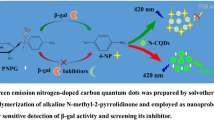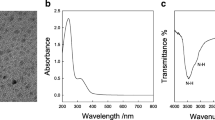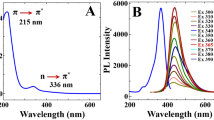Abstract
A fluorescence (FL) probe for determination of γ-glutamyl transpeptidase (GGT) activity and evaluation of inhibitors was developed based on the inner filter effect (IFE) of nitrogen-doped carbon dots (N-CDs). Bright green emissive N-CDs were synthesized by one-step hydrothermal technique with catechol and ethylenediamine. The excitation and emission wavelengths for N-CDs were 408 and 510 nm, respectively. γ-l-Glutamyl-4-nitroanilide (γ-G4NA) was employed as the substrate of GGT. The absorption spectrum of GGT catalytic product (4-nitroaniline, 4-NA) overlapped greatly with the excitation spectrum of N-CDs. 4-NA acted as the absorber in IFE to quench the FL of N-CDs. Thus, the FL quenching of N-CDs was closely related to GGT activity. The established FL method offered good linear relationship within 2.0–10.0 U L−1 (R2, 0.982) and 10.0–110.0 U L−1 (R2, 0.998) with a low detection limit of 0.6 U L−1. The method was successfully applied to investigate GGT activity in human serum samples with acceptable recoveries (99.1–105.0%). The approach was also employed for screening GGT inhibitors from different polar extracts of Schisandra chinensis. Results indicated that this strategy presents superior characteristics for GGT sensing. This method has great potential as a candidate for diagnosis of GGT-related diseases and high-throughput drug discovery.

Graphical abstract







Similar content being viewed by others
References
Castellano I, Merlino A, Rossi M, La Cara F (2010) Biochemical and structural properties of gamma-glutamyl transpeptidase from Geobacillus thermodenitrificans: an enzyme specialized in hydrolase activity. Biochimie 92:464–474
Pompella A, De Tata V, Paolicchi A, Zunino F (2006) Expression of γ-glutamyltransferase in cancer cells and its significance in drug resistance. Biochem Pharmacol 71:231–238
Choi YJ, Lee DH, Han K-D, Yoon H, Shin CM, Park YS, Kim N (2017) Elevated serum gamma-glutamyltransferase is associated with an increased risk of oesophageal carcinoma in a cohort of 8,388,256 Korean subjects. PLoS One 12:0177053–0177064
Kiuchi K, Nagatsu T, Togari A, Kumagai H (1986) Highly sensitive assay for γ-glutamyltranspeptidase activity by high-performance liquid chromatography with electrochemical detection. J Chromatogr A 357:191–198
Orlowski M, Meister A (1963) γ-Glutamyl-p-nitroanilide: a new convenient substrate for determination and study of L- and D-γ-glutamyltranspeptidase activities. Biochim Biophys Acta 73:679–681
Del Corso A, Cappiello M, Buono F, Moschini R, Paolicchi A, Mura U (2006) Colorimetric coupled enzyme assay for γ-glutamyltransferase activity using glutathione as substrate. J Biochem Biophys Methods 67:123–130
Chen G, Ni S, Zhu S, Yang J, Yin Y (2012) An electrochemical method to detect gamma glutamyl transpeptidase. Int J Mol Sci 13:2801–2809
Jiang L, Guo D, Wang L, Chang S, Li J, Zhan D, Fodjo EK, Gu H, Li D (2019) Sensitive and selective SERS probe for detecting the activity of γ-glutamyl transpeptidase in serum. Anal Chim Acta DOI. https://doi.org/10.1016/j.aca.2019.11.041
Zhang P, Jiang X, Nie X, Huang Y, Zeng F, Xia X, Wu S (2016) A two-photon fluorescent sensor revealing drug-induced liver injury via tracking γ-glutamyltranspeptidase (GGT) level in vivo. Biomaterials 80:46–56
Hou X, Yu Q, Zeng F, Yu C, Wu S (2014) Ratiometric fluorescence assay for γ-glutamyltranspeptidase detection based on a single fluorophore via analyte-induced variation of substitution. Chem Commun 50:3417–3420
Luo Z, An R, Ye D (2019) Recent advances in the development of optical imaging probes for γ-Glutamyltranspeptidase. Chem Bio Chem 20:474–487
Das RK, Mohapatra S (2017) Highly luminescent, heteroatom-doped carbon quantum dots for ultrasensitive sensing of glucosamine and targeted imaging of liver cancer cells. J Mater Chem B 5:2190–2197
Yang Z, Xu M, Liu Y, He F, Gao F, Su Y, Wei H, Zhang Y (2014) Nitrogen-doped, carbon-rich, highly photoluminescent carbon dots from ammonium citrate. Nanoscale 6(3):1890–1895
Wang L, Zhou HS (2014) Green synthesis of luminescent nitrogen-doped carbon dots from milk and its imaging application. Anal Chem 86(18):8902–8905
Shangguan J, He D, He X, Wang K, Xu F, Liu J, Tang J, Yang X, Huang J (2016) Label-free carbon-dots-based ratiometric fluorescence pH nanoprobes for intracellular pH sensing. Anal Chem 88(15):7837–7843
Li T, Xie L, Long R, Tong C, Guo Y, Tong X, Shi S, Lin Q (2019) Cetyltrimethyl ammonium mediated enhancement of the red emission of carbon dots and an advanced method for fluorometric determination of iron(III). Microchim Acta 186(12):791–798
Li Y, Liu X, Wu Q, Yi J, Zhang G (2018) Discrimination and detection of benzaldehyde derivatives using sensor array based on fluorescent carbon nanodots. Sens Actuators B: Chem 261:271–278
Pirsaheb M, Mohammadi S, Salimi A, Payandeh M (2019) Functionalized fluorescent carbon nanostructures for targeted imaging of cancer cells: a review. Microchim Acta 186:231–240
Long R, Guo Y, Xie L, Shi S, Xu J, Tong C, Lin Q, Li T (2020) White pepper-derived ratiometric carbon dots for highly selective detection and imaging of coenzyme A. Food Chem DOI. https://doi.org/10.1016/j.foodchem.2020.126171
Tang C, Qian Z, Huang Y, Xu J, Ao H, Zhao M, Zhou J, Chen J, Feng H (2016) A fluorometric assay for alkaline phosphatase activity based on β-cyclodextrin-modified carbon quantum dots through host-guest recognition. Biosens Bioelectron 83:274–280
Chang L, He X, Chen L, Zhang Y (2017) A novel fluorescent turn-on biosensor based on QDs@ GSH–GO fluorescence resonance energy transfer for sensitive glutathione S-transferase sensing and cellular imaging. Nanoscale 9:3881–3888
Li G, Kong W, Zhao M, Lu S, Gong P, Chen G, Xia L, Wang H, You J, Wu Y (2016) A fluorescence resonance energy transfer (FRET) based “turn-on” nanofluorescence sensor using a nitrogen-doped carbon dot-hexagonal cobalt oxyhydroxide nanosheet architecture and application to α-glucosidase inhibitor screening. Biosens Bioelectron 79:728–735
Huang S, Yang E, Yao J, Liu Y, Xiao Q (2018) Carbon dots doped with nitrogen and boron as ultrasensitive fluorescent probes for determination of α-glucosidase activity and its inhibitors in water samples and living cells. Microchim Acta 185:394–403
Gong P, Sun L, Wang F, Liu X, Yan Z, Wang M, Zhang L, Tian Z, Liu Z, You J (2019) Highly fluorescent N-doped carbon dots with two-photon emission for ultrasensitive detection of tumor marker and visual monitor anticancer drug loading and delivery. Chem Eng J 356:994–1002
Lu S, Li G, Lv Z, Qiu N, Kong W, Gong P, Chen G, Xia L, Guo X, You J (2016) Facile and ultrasensitive fluorescence sensor platform for tumor invasive biomaker β-glucuronidase detection and inhibitor evaluation with carbon quantum dots based on inner-filter effect. Biosens Bioelectron 85:358–362
Tang D, Zhang J, Zhou R, Xie Y, Hou X, Xu K, Wu P (2018) Phosphorescent inner filter effect-based sensing of xanthine oxidase and its inhibitors with Mn-doped ZnS quantum dots. Nanoscale 10:8477–8482
Mao M, Tian T, He Y, Ge Y, Zhou J, Song G (2017) Inner filter effect based fluorometric determination of the activity of alkaline phosphatase by using carbon dots codoped with boron and nitrogen. Microchim Acta 185:17–22
Xu X, Cen Y, Xu G, Wei F, Shi M, Hu Q (2019) A ratiometric fluorescence probe based on carbon dots for discriminative and highly sensitive detection of acetylcholinesterase and butyrylcholinesterase in human whole blood. Biosens Bioelectron 131:232–236
Wen Q, Zhu C, Liu L, Yang Q, Wang S, Zhu D (2012) Synthesis of a bifunctional fluorescent polymer for cell imaging and enzyme detection. Macromol Chem Phys 213:2486–2491
Lin M, Zou H, Yang T, Liu Z, Liu H, Huang C (2016) An inner filter effect based sensor of tetracycline hydrochloride as developed by loading photoluminescent carbon nanodots in the electrospun nanofibers. Nanoscale 8:2999–3007
Buss H, Chan TP, Sluis KB, Domigan NM, Winterbourn CC (1997) Protein carbonyl measurement by a sensitive ELISA method. Free Radic Biol Med 23:361–366
Li H, Yao Q, Xu F, Xu N, Duan R, Long S, Fan J, Du J, Wang J, Peng X (2018) Imaging γ-glutamyltranspeptidase for tumor identification and resection guidance via enzyme-triggered fluorescent probe. Biomaterials 179:1–14
Su L, Li P, Lu T, Mao C, Ji D, Hao M, Huang Z (2019) Protective effect of Schisandra chinensis total lignans on acute alcoholic-induced liver injury related to inhibiting CYP2E1 activation and activating the Nrf2/ARE signaling pathway. Rev Bras 29(2):198–205
Pereira C, Barros L, Ferreira IC (2016) Extraction, identification, fractionation and isolation of phenolic compounds in plants with hepatoprotective effects. J Sci Food Agric 96:1068–1084
Funding
This work was supported by the National Natural Science Foundation of China (31660181), the Natural Science Foundation of Hunan Province, China (2018JJ1043), and Key Laboratory of Hunan Province for Water Environment and Agriculture Product Safety (2018TP1003).
Author information
Authors and Affiliations
Corresponding authors
Ethics declarations
Conflict of interest
All the authors declare no conflict of interest.
Additional information
Publisher’s note
Springer Nature remains neutral with regard to jurisdictional claims in published maps and institutional affiliations.
Electronic supplementary material
ESM 1
(DOCX 1171 kb)
Rights and permissions
About this article
Cite this article
Tong, X., Li, T., Long, R. et al. Determination of the activity of γ-glutamyl transpeptidase and of its inhibitors by using the inner filter effect on the fluorescence of nitrogen-doped carbon dots. Microchim Acta 187, 182 (2020). https://doi.org/10.1007/s00604-020-4160-8
Received:
Accepted:
Published:
DOI: https://doi.org/10.1007/s00604-020-4160-8




